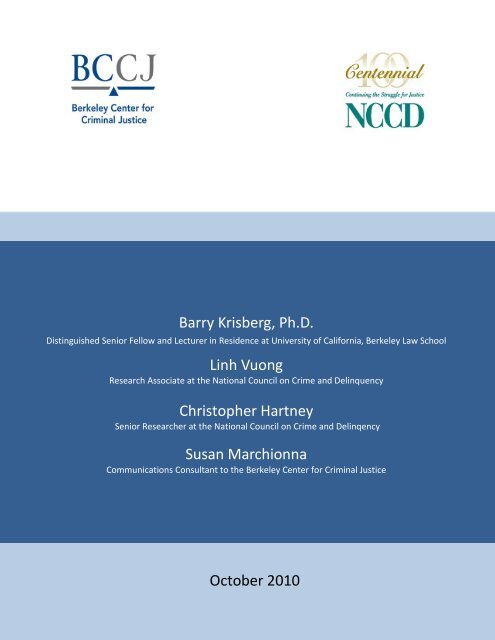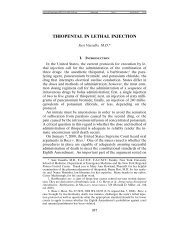October 2010 Barry Krisberg, Ph.D. Linh Vuong Christopher Hartney ...
October 2010 Barry Krisberg, Ph.D. Linh Vuong Christopher Hartney ...
October 2010 Barry Krisberg, Ph.D. Linh Vuong Christopher Hartney ...
Create successful ePaper yourself
Turn your PDF publications into a flip-book with our unique Google optimized e-Paper software.
<strong>Barry</strong> <strong>Krisberg</strong>, <strong>Ph</strong>.D.<br />
Distinguished Senior Fellow and Lecturer in Residence at University of California, Berkeley Law School<br />
<strong>Linh</strong> <strong>Vuong</strong><br />
Research Associate at the National Council on Crime and Delinquency<br />
<strong>Christopher</strong> <strong>Hartney</strong><br />
Senior Researcher at the National Council on Crime and Delinqency<br />
Susan Marchionna<br />
Communications Consultant to the Berkeley Center for Criminal Justice<br />
<strong>October</strong> <strong>2010</strong>
A New Era in California Juvenile Justice<br />
EXECUTIVE SUMMARY<br />
California created a statewide system of youth<br />
corrections facilities in 1941. The newly formed<br />
California Youth Authority (CYA) was considered a<br />
major progressive step forward in juvenile justice.<br />
Part of its focus in its early years was<br />
programming designed to keep youth close to<br />
their home communities. In its first three decades,<br />
the CYA population never exceeded 7,000.<br />
Leadership and policy changes in the late 1970s<br />
and early 1980s, however, started a long period of<br />
increase in the CYA population.<br />
By 1996, the number of incarcerated youth in the<br />
CYA grew steadily to over 10,000. The rise was<br />
driven by several major factors: a fear that a<br />
growing California youth population was<br />
increasingly dangerous, a decrease in state<br />
funding to counties for local programs, and the<br />
cost savings to counties of sending youth to the<br />
CYA rather than county facilities or group homes.<br />
After 1996, the trend of a rising youth inmate<br />
population turned around, with fewer and fewer<br />
young people being held in the CYA. By the end of<br />
2009, the CYA held 1,499 youth. This decline in<br />
the CYA population is the largest drop in youth<br />
confinement that has been experienced by any<br />
state.<br />
The research presented here attempts to examine<br />
the many factors that may have contributed to<br />
that “decarceration.” We also examine concurrent<br />
trends in crime, arrests, and the use of other,<br />
non-CYA forms of custody for these youth.<br />
In 1996, California began to reverse traditional<br />
funding trends and passed legislation to make<br />
counties pay more to send youth to the CYA. The<br />
state also began giving grants to counties to build<br />
new juvenile facilities and implement new<br />
alternative sentencing programs. The influence of<br />
1<br />
youth advocacy groups such as Books Not Bars,<br />
the Youth Law Center, the Commonweal Institute,<br />
and National Council on Crime and Delinquency<br />
(NCCD) intensified in the early 2000s. However,<br />
the voters continued to embrace policies such as<br />
Proposition 21, which increased penalties for<br />
many crimes and made it easier to move young<br />
offenders to the adult courts. Also, a<br />
reorganization of state corrections under<br />
Governor Schwarzenegger moved the CYA under<br />
the control of the California Department of<br />
Corrections and Rehabilitation (CDCR), despite the<br />
objections of most juvenile justice professionals<br />
and youth advocates. The CYA is now known as<br />
the Division of Juvenile Facilities (DJF) under the<br />
CDCR. (For the purposes of this paper, we<br />
continue to refer to the agency by its older name,<br />
CYA.)<br />
Reports of substandard conditions of confinement<br />
in the CYA began to surface, prompting the<br />
legislature to hold public hearings. The Office of<br />
the Inspector General conducted a series of<br />
investigations about alleged abusive practices at<br />
state juvenile prisons. The media began<br />
highlighting these abuses with several in-depth<br />
investigative reports. As the deplorable conditions<br />
of confinement for youth in custody appeared on<br />
front pages, some of the people responsible for<br />
sending youth to the CYA—judges, probation<br />
officers, and prosecutors—began to express public<br />
concerns that their decisions may have been doing<br />
more harm than good.<br />
In the face of these allegations of abuse, growing<br />
evidence that recidivism rates were very high, and<br />
because the CYA had become so expensive,<br />
sending youth to state facilities became<br />
increasingly unpopular. The negative publicity<br />
worsened in 2003 in the wake of a major lawsuit
A New Era in California Juvenile Justice<br />
brought by the Prison Law Office. Part of the<br />
litigation involved an independent investigation of<br />
the CYA funded by the California attorney general<br />
in 2003. With the investigation findings public, the<br />
state quickly entered into a consent decree in<br />
Farrell v. Harper, which mandated reform of many<br />
aspects of the CYA. In 2007, legislators enacted<br />
comprehensive reforms to “realign” the juvenile<br />
justice system, requiring that nonviolent juvenile<br />
offenders and parole violators be kept at the local<br />
level and shifting some funding to counties to<br />
manage the new clients.<br />
Despite the many changes in the juvenile justice<br />
system over the last 15 years, significant reforms<br />
2<br />
in state juvenile facilities are still a “work in<br />
progress.” Significant levels of violence are still<br />
occurring at some facilities and evidence-based<br />
rehabilitation programs are still being designed<br />
and pilot-tested. Although some observers,<br />
including the Little Hoover Commission, and many<br />
youth advocates continue to call for the closing of<br />
the CYA altogether, for now, state facilities<br />
provide a needed setting for more serious youth<br />
offenders whose needs are not being met at the<br />
local level. Without a better option than existing<br />
county programs, there is concern that there will<br />
be an influx of youth being sent to adult prisons<br />
and jails, a placement far worse than the CYA<br />
itself.<br />
This study was supported by grants from the Van Löben Sels RembeRock Foundation, the San Francisco<br />
Foundation, and the W.T Grant Foundation. The views expressed in this report are those of the authors and<br />
do not necessarily represent those of the funders.
A New Era in California Juvenile Justice<br />
INTRODUCTION<br />
Behind the media and political attention focused<br />
on California prisons, which are plagued with<br />
severe levels of crowding, and a federal court<br />
order to reduce the inmate population by over<br />
40,000, lies one of California’s best-kept secrets:<br />
the state’s youth correctional custodial population<br />
has declined over 80% in just over the past<br />
decade. Just since 2004 the California Youth<br />
Authority (CYA) population declined by over 5,000<br />
inmates. The state has already closed five major<br />
juvenile facilities and four forestry camps for<br />
juvenile offenders.<br />
A number of factors have contributed significantly<br />
to the drop in the population of the CYA, now<br />
known as the Division of Juvenile Facilities ∗ under<br />
the California Department of Corrections and<br />
Rehabilitation (CDCR). The most frequently cited is<br />
the very negative media publicity in the early<br />
2000s about the conditions inside facilities, the<br />
case of Farrell v. Harper in 2003, and realignment<br />
legislation passed in 2007 that required that more<br />
youthful offenders be managed at the county<br />
level. However, the CYA population began<br />
declining as early as 1997—before these events.<br />
The trend towards increased costs for counties to<br />
send youth to the CYA, and doubt that the CYA<br />
was an appropriate setting for many of the youth<br />
being sent there, had already begun in the late<br />
1990s.<br />
While no single factor accounts for the drastic<br />
change in the CYA population, the research<br />
presented here points to multiple forces that<br />
came together in the mid- to late-1990s and early<br />
2000s to change public perception, judicial<br />
behaviors, probation programs, sentencing<br />
policies, and state funding streams.<br />
∗ For clarity, this report uses the older acronym CYA to refer<br />
to the state agency operating juvenile corrections facilities.<br />
3<br />
We also find that this population reduction is<br />
particularly notable because it did not result in an<br />
increase in juvenile crime, as some had<br />
erroneously predicted.<br />
METHODS<br />
In preparing this report, the authors gathered data<br />
from several state agencies, conducted interviews<br />
with individuals who had first-hand knowledge<br />
about the decline in the CYA population, and<br />
reviewed media coverage of youth crime. The<br />
data sources revealed how the numbers changed,<br />
and the interviews and the media review provided<br />
the context around the changing numbers. The<br />
data sources include the California Attorney<br />
General’s Criminal Justice Statistics Center for<br />
juvenile arrest and placement data, and the<br />
Corrections Standard Authority for historical data<br />
on new admissions to the California Youth<br />
Authority. Interviews were conducted with those<br />
who worked on the issue at a macro-level, such as<br />
youth advocates (Lenore Anderson, former<br />
director of Books Not Bars; David Steinhart,<br />
Director of the Commonweal Juvenile Justice<br />
Program; Daniel Macallair, Executive Director of<br />
the Center on Juvenile and Criminal Justice; Sue<br />
Burrell, Youth Law Center), and with those who<br />
saw the changes happen at the local level, such as<br />
chief probation officers (Chiefs Jerry Powers of<br />
Stanislaus County and Donald H. Blevins of Los<br />
Angeles County, formerly of Alameda County) and<br />
the court (Kurt Kumli, Superior Court Judge in<br />
Santa Clara County and formerly chief deputy<br />
district attorney). A media review was conducted<br />
through LexisNexis and several major reports<br />
were also consulted.
A New Era in California Juvenile Justice<br />
HISTORY AND MANDATE OF THE CYA<br />
Rehabilitation has been the primary goal of the<br />
California juvenile justice system for more than a<br />
half century. According to the Welfare and<br />
Institutions Code 1700, the juvenile system is<br />
designed to 1) protect public safety and<br />
2) rehabilitate youthful offenders through<br />
community and victim restoration and offender<br />
training and treatment in lieu of retributive<br />
punishment. This attitude was also reflected<br />
nationally, as evidenced by the Youth Corrections<br />
Authority Act of 1940, the model legislation with<br />
the intent of rehabilitating offenders between the<br />
ages of 16–21. This age range was deemed “a<br />
more promising time of life for dealing with<br />
delinquents or criminals than any later period.” 1<br />
California passed this Act in 1941 and in the<br />
process created the California Youth Authority<br />
(CYA).<br />
The newly established CYA was celebrated as a<br />
major, progressive step forward in juvenile justice.<br />
During its first three decades, the CYA was led by<br />
Herman G. Stark, Karl Holton, and Allen Breed,<br />
each a nationally known leader in the field. During<br />
this period, the youth resident population of the<br />
CYA never exceeded 7,000. During the 1960s and<br />
1970s, the CYA instituted a number of programs<br />
designed to keep delinquent youth in local<br />
placements. However, during the administration<br />
of Governor Jerry Brown, many of these<br />
community-based programs were eliminated and<br />
the population in state juvenile facilities began to<br />
steadily rise through the administrations of<br />
Governors George Deukmejian, Peter Wilson, and<br />
Gray Davis.<br />
1 Coghill, H. (1943). The proposed Youth Correction<br />
Authority Act. American Journal of Psychiatry, 99, 890–893.<br />
4<br />
The Commitment Process<br />
The process of sending youth to CYA<br />
begins at the county level, with<br />
prosecutors, public defenders, probation<br />
officers, juvenile court judges and others<br />
who play a role in determining if a youth<br />
will be placed out of home and, if so,<br />
where and for how long. Rehabilitation is<br />
meant to be a top priority. There are<br />
several options for processing arrested<br />
youth, most of which are far less harsh<br />
than commitment to CYA. After arrest,<br />
youth can be referred to probation or<br />
counseled and released. Once referred,<br />
probation officers can close the case, place<br />
youth on probation, divert youth away from<br />
the system, or file a petition in juvenile<br />
court. Judges determine whether the youth<br />
is deemed delinquent and make final<br />
sentencing decisions, including maximum<br />
confinement time, based on<br />
recommendations by probation officers, the<br />
district attorney, and defense attorney. At<br />
this point, youth can be placed under state<br />
wardship, placed on probation, diverted, or<br />
dismissed. Wardship placements can<br />
include home supervision, county facilities,<br />
group homes, health or welfare facilities, or<br />
CYA. At each of the decision points from<br />
arrest through disposition, the youth may<br />
also be transferred for processing in the<br />
adult system. It is county probation<br />
departments that bear the cost of a youth’s<br />
placement, whether it is local, state, or out<br />
of state.
A New Era in California Juvenile Justice<br />
A GROWING STATE YOUTH CORRECTIONS<br />
POPULATION<br />
Although it held as many as 6,700 in 1965, the CYA<br />
population was never over 5,000 in the 1970s (see<br />
Figure 1). Then began a long period of growth,<br />
surpassing 6,000 in 1984, 8,000 in 1987, and<br />
reaching its peak of 10,122 youth in 1996. The rise<br />
in the incarcerated population was fueled by fears<br />
that there was a growing number of very violent<br />
youth in California, especially those involved in<br />
gangs. Furthermore, the rise in commitments to<br />
the CYA was driven by two cost factors. First, since<br />
the late 1960s, the state had given counties<br />
money for local programs, encouraging<br />
rehabilitation of offenders at the local level. The<br />
California Probation Subsidy Act of 1965 paid<br />
counties $4,000 for each adult or juvenile who<br />
could be diverted to probation instead of<br />
incarcerated. This state subsidy ended in 1978,<br />
but was replaced with the County Justice System<br />
Subvention Program, which gave state grants to<br />
counties for local programming. By 1992,<br />
however, because costs continued to rise but the<br />
level of state funding did not, these grants<br />
covered less than 10% of actual county<br />
expenditures on local juvenile justice programs. 2<br />
Secondly, sending youth to state prison was<br />
inexpensive compared to keeping them at the<br />
county level. Until 1996, it cost counties only<br />
$25/month to commit a youth to the state.<br />
2 Nieto, M. (1996). The changing role of probation in<br />
California’s criminal justice system. Sacramento: California<br />
Research Bureau.<br />
5<br />
The CYA had the facilities and infrastructure that<br />
the counties did not have for holding wards on a<br />
long-term basis, but these cost incentives had the<br />
effect of encouraging counties to send short-term<br />
wards to the state as well. At least until the early<br />
1990s, the counties did so with some confidence<br />
in the CYA’s standards and practices. Although<br />
some advocates, lawmakers, and judges were<br />
starting to doubt that it was always an appropriate<br />
setting for the youth sent there, most<br />
stakeholders believed the CYA to have decent<br />
facilities, programming, and services. In fact,<br />
probation officers reported being as shocked as<br />
the public when horrible stories about the CYA<br />
later began making front-page news.<br />
A SHRINKING STATE YOUTH CORRECTIONS<br />
POPULATION<br />
Figure 1 shows that since its peak in 1996 the CYA<br />
population has steadily declined, falling to 1,499 in<br />
December 2009. Pending legislation would make<br />
the state youth corrections system even smaller<br />
and experts believe the population will continue<br />
to decline. 3<br />
3 California Department of the Youth Authority, Ward<br />
Information and Parole Research Bureau. (n.d.). A<br />
comparison of the Youth Authority’s institution and parole<br />
populations: June 30 each year, 1993–2002. See<br />
http://www.cdcr.ca.gov/reports_research/docs/research/po<br />
ps_93-02.pdf.
A New Era in California Juvenile Justice<br />
Admissions and Length of Stay<br />
Figure 1<br />
Like any custodial system, the CYA population is determined by the number of admissions and the<br />
length of stay of these admissions. The changes in policy and practice described in this report mainly<br />
speak to changes in admissions. While length of stay has increased somewhat, the driving force<br />
behind the decline in the CYA population has been a decline in admissions.<br />
New admissions fluctuated between 3,500 and 4,000 from 1985 to 1996. Then began a sharp<br />
decline, with new admissions dropping a full third in the year after the state began charging the<br />
counties more for youth sent to the CYA, and continuing to drop to just 504 new admissions in 2009.<br />
The average length of stay among CYA inmates also fluctuated, but generally rose since the late<br />
1990s. The average length of stay in the decade leading up to 1996 was 21.1 months, while between<br />
1997 and 2009 it was 25.4 months. This change was most likely due to toughened penalties for<br />
youth offenders as well as lower-level offenders being sent to counties, thereby increasing the<br />
proportion of more serious offenders with longer sentences sent to the CYA. 4<br />
4 CDCR (<strong>2010</strong>). Population Movement Summaries. See<br />
http://www.cdcr.ca.gov/Juvenile_Justice/Research_and_Statistics/index.html.<br />
6
A New Era in California Juvenile Justice<br />
IMPACT ON PUBLIC SAFETY<br />
Reported Crime<br />
Prior to 1996, California’s rate of reported violent crime was rising while the property crime rate was falling.<br />
From 1996 to 2009, both violent and property crime rates steadily declined to their 25-year lows of 454 per<br />
100,000 for violent crimes and 1,548 per 100,000 for property crimes in 2009. 5 The dramatic decline in the<br />
CYA population was not associated with an increase in crimes reported to the police.<br />
Juvenile Arrests<br />
The juvenile felony arrest rate reached a 25-year high in 1991, at 2,902. Figure 2 shows that the rate<br />
consistently declined since then—throughout the years of the decline in the CYA population—to 1,345 per<br />
100,000 youth aged 10–17 in the general population in 2004 and, after a brief rise in 2005–06, dropped to a<br />
50-year low of 1,290,345 per 100,000 youth aged 10–17 in the general population in 2009. 6<br />
This drop in juvenile arrests is important in two ways. First, to some extent, it most likely contributed to the<br />
decline in CYA custody—fewer arrests generally mean fewer youth in the system. Second, and more<br />
importantly, the decline in CYA custody did not contribute to a decrease in public safety (that is, a rise in<br />
arrests), as some feared it would.<br />
Figure 2<br />
5<br />
California, Office of the Attorney General, Criminal Justice Statistics Center. (<strong>2010</strong>). Crime in California, 1983–2009: By category.<br />
See http://ag.ca.gov/cjsc/glance/data/1data.txt<br />
6<br />
California, Office of the Attorney General, Criminal Justice Statistics Center. (<strong>2010</strong>). California arrest rates, 1960–2009: Total<br />
felony violations. See http://ag.ca.gov/cjsc/glance/data/5data.txt<br />
7
A New Era in California Juvenile Justice<br />
Adult Arrests and Incarceration<br />
Similar to juvenile arrest rates, the adult felony arrest rate began a decline in the 1990s from a high in<br />
1989 of 2,577 to 1,586 in 2009. 7 This is relevant to the CYA population decline since many of the youth<br />
who exit the youth prisons have passed their 18th birthday and are eligible to be arrested as adults.<br />
Unlike CYA population figures, California’s prison population grew in this period, from 131,232 in 1995<br />
to 166,569 in August 2009. 8<br />
ALTERNATIVES TO THE CYA<br />
County Custody<br />
A question that arises when one considers that counties no longer send as many of their delinquent<br />
youth to the CYA is, where did they go? Counties have several alternatives to the CYA. Most youth<br />
sentenced to residential placement in the county will serve their time in juvenile hall or county camps<br />
or ranches. Figure 3 9 illustrates that, while there were some increases at the beginning of the past 10<br />
years, the number of post-disposition youth placed in these settings has remained static or dropped.<br />
(Youth being detained in juvenile halls awaiting trial are not included in these numbers, since CYA<br />
youth are not likely to have that status.)<br />
Figure 3<br />
7<br />
California, Office of the Attorney General, Criminal Justice Statistics Center. (<strong>2010</strong>). California arrest rates, 1960–2009:<br />
Total felony violations. See http://ag.ca.gov/cjsc/glance/data/5data.txt<br />
8<br />
CDCR. (2009, Fall). Corrections: Moving forward (CDCR Annual Report). See<br />
http://www.cdcr.ca.gov/News/2009_Press_Releases/docs/CDCR_Annual_Report.pdf<br />
9<br />
Corrections Standards Authority. (<strong>2010</strong>). Juvenile hall population summary, 1993–2008 and Camps population summary,<br />
1993–2008. Obtained via special request.<br />
8
A New Era in California Juvenile Justice<br />
A key alternative to incarceration is home supervision or probation, in which the youth lives at home<br />
under supervision of the probation department. Figure 4 10 shows rising trends in the use of home<br />
supervision, which usually includes intensive supervision, electronic monitoring, day reporting, or some<br />
other form of probation.<br />
Transfers to the Adult System<br />
Figure 4<br />
In the past few years, California has seen an increase in direct files to adult court (Figures 5 and 6). 11<br />
Serious juvenile cases may go to adult court if a juvenile is deemed unfit for juvenile proceedings, but<br />
in such a case, a prosecutor has initially filed the case in the juvenile court. With a direct file to adult<br />
court, a prosecutor bypasses the juvenile justice system. In addition to Proposition 21, which required<br />
that juveniles charged with certain violent crimes be tried in adult court, the increase of direct-file<br />
cases may reflect that prosecutors believe that there are fewer options for very serious offenders in<br />
lieu of the CYA. With many judges tacitly refusing to commit youth to the CYA, and because many<br />
county facilities are not designed to hold juveniles for extended periods of time, prosecutors may be<br />
resorting to direct file. However, this tactic may not be succeeding. There has not been a major change<br />
in the number of persons under the age of 20 serving time in adult facilities, suggesting that the rise in<br />
direct files has not resulted in more young people being sent to CDCR. For example, in 1999 there were<br />
2,811 new admissions to CDCR of persons under the age of 20. By 2009, after the major decline in the<br />
CYA population, the number of felony admissions to CDCR of youth under age 20 was only 2,594. 12<br />
10<br />
California, Office of the Attorney General. (<strong>2010</strong>). Juvenile justice in California 2002–2008 [Series]. See<br />
http://www.ag.ca.gov/cjsc/pubs.php#juvenileJustice<br />
11<br />
California, Department of Justice, Office of the Attorney General. (<strong>2010</strong>). Juvenile justice in California 2002–2009 [Series].<br />
See http://www.ag.ca.gov/cjsc/pubs.php#juvenileJustice<br />
12<br />
See http://www.cdcr.ca.gov/Reports_Research/Offender_Information_Services_Branch/index.html.<br />
9
A New Era in California Juvenile Justice<br />
*This table revised <strong>October</strong>, 2011.<br />
Figure 5<br />
Figure 6*<br />
10
A New Era in California Juvenile Justice<br />
CONTEXT OF THE DECLINE<br />
Rehabilitation at the County Level<br />
After the CYA population peaked in 1996, it<br />
began a steady decline that continues today. In<br />
the mid-1990s, CYA facilities were growing<br />
increasingly crowded, so CYA administrators<br />
developed plans for increasing capacity by 25%,<br />
mainly through new construction. State<br />
lawmakers balked, citing the costs to the state,<br />
the increasing use of the CYA as a catch-all<br />
system for even very low-level offenders, and<br />
growing concern about the quality of care<br />
received there. Instead the legislature passed<br />
SB 681 in 1996, which set up a sliding scale of<br />
costs, making the minimum monthly payment<br />
$150 per month per juvenile offender.<br />
Payments increased as severity of offense<br />
decreased, with the least severe offenders<br />
costing counties $2,600 per month, or 100% of<br />
the actual cost to the state. This structure<br />
encouraged counties to find rehabilitative<br />
options for less serious youth at the county<br />
level; the CYA should be reserved for the most<br />
serious youth, whose needs could not be met<br />
at the county level. Several other factors were<br />
also at work. AB 2312, also passed in 1996,<br />
authorized $33 million to support local juvenile<br />
justice programs. The Juvenile Crime<br />
Enforcement and Accountability Challenge<br />
Grants gave nearly $50 million to local counties<br />
to support graduated sanctions at the local<br />
level and nearly $500 million for the<br />
construction of local juvenile facilities.<br />
Increasing Costs of the CYA<br />
The cost to the state to house a youth in the<br />
CYA has always been higher than adult prison,<br />
in part because of the serious needs of youth<br />
sent there. Other factors contributing to high<br />
per-capita CYA costs include the salaries of CYA<br />
11<br />
corrections staff and maintenance of<br />
deteriorating state youth facilities. In 1996, the<br />
annual cost to house a ward in the CYA was<br />
$36,118. In 2003, before the Farrell consent<br />
decree, this cost had already risen to $83,223.<br />
The Farrell consent decree has required hiring<br />
more medical, mental health, and education<br />
staff for CYA facilities and this has led to cost<br />
increases. As the youth custodial population<br />
has decreased and a number of CYA facilities<br />
have been mothballed, the agency’s overhead<br />
costs have remained largely the same and state<br />
personnel rules have slowed the process of<br />
reducing the CYA workforce. This drove the<br />
annual cost per youth to $218,000 in 2007.<br />
With California’s state budget already in crisis<br />
by 2001, it is not surprising that the CYA<br />
became a target for budget cuts and pressures<br />
to close more CYA facilities.<br />
Realignment Legislation<br />
In 2007, the state passed historic “realignment”<br />
legislation: SB 81. Though it had been pushed<br />
for before 2007, many believe that the growing<br />
cost of the CYA, along with the cost of<br />
implementing the reforms required by the<br />
Farrell lawsuit, helped SB 81 to pass when it<br />
did. The bill redefined placement options,<br />
allowing only the most serious violent<br />
offenders and sex offenders to be sent to the<br />
state; all other offenders had to be kept in<br />
county facilities. (Counties were also allowed,<br />
but generally not forced, to recall from the CYA<br />
juvenile offenders who had been committed on<br />
a nonserious offense.) SB 81 further changed<br />
the population of the CYA, as nonviolent youth<br />
were no longer sent to state facilities. Although<br />
the state provided some additional money to<br />
the counties for their increased caseloads,<br />
many chief probation officers felt blindsided.<br />
With little warning, they had to accept youth<br />
into their facilities who were previously sent to<br />
the CYA. The chief probation officers had
A New Era in California Juvenile Justice<br />
initially opposed SB 81 and complained that<br />
they had little time to prepare their facilities<br />
and programs for the changes. There is ongoing<br />
uncertainty that state funding to offset county<br />
costs will still be available as the state budget<br />
deficit becomes more severe.<br />
The reduction in new admissions to the CYA<br />
averaged several hundred fewer youth each<br />
year statewide. While not all of these youth<br />
were sent to county placement options, this is a<br />
substantial number that could not easily be<br />
absorbed into the various county placement<br />
options. The influx, which included young<br />
people with multiple mental health, special<br />
education, and substance abuse treatment<br />
needs, and the associated costs of providing<br />
these services made for big changes in the<br />
already burdened and tightly budgeted county<br />
systems. Furthermore, since youth who were<br />
sent to the CYA and youth who remained with<br />
the counties were based on each youth’s<br />
current offense without regard to priors, youth<br />
with very serious offense histories currently<br />
being held for a lesser offense remained the<br />
responsibility of the counties. For example, a<br />
youth with several violent priors currently<br />
being held for a relatively minor property<br />
offense would stay with the county, even<br />
though his priors might suggest the need for a<br />
more secure setting. Probation chiefs feel this<br />
new county population has contributed to<br />
increases of in-custody incidents, gang activity,<br />
and difficulty in finding appropriate<br />
programming for these deeper-end youth.<br />
There are, however, no data that support these<br />
anecdotal observations. On the other hand,<br />
chief probation officers interviewed for this<br />
report also held the view that probation<br />
departments have come out better for<br />
realignment. Counties have been forced to get<br />
creative, to augment or develop local programs<br />
for youth, and to change the way their local<br />
facilities are run. They have increased the use<br />
12<br />
of such approaches as community probation<br />
and intensive supervision, and have increased<br />
prevention efforts. They have found that<br />
keeping these youth at the local level is not<br />
only cheaper than the current costs of the CYA,<br />
but it gives youth access to local programs and<br />
services and keeps them connected to their<br />
families and communities.<br />
INSTITUTIONAL ABUSE AND THE<br />
STRUGGLE FOR YOUTH JUSTICE<br />
Despite the decrease in the incarcerated youth<br />
population that commenced towards the end<br />
of the 1990s, the CYA’s problems continued.<br />
The violence within the state facilities was<br />
beginning to become public, starting with the<br />
inmate murder of a CYA counselor, Ineasie<br />
Baker, in 1996. Many familiar with the CYA<br />
believe that it was this incident that began the<br />
era of extensive 23-hour solitary confinement<br />
of many youth. The practice of 23-hour lockups<br />
consisted of isolating youth (with behavioral<br />
and psychological problems) in their cells for<br />
23 hours a day, for days and even months on<br />
end, with one hour of large-muscle exercise. 13<br />
In some instances, the Office of the Inspector<br />
General found that youth were denied this one<br />
hour and, in other instances, that this one hour<br />
of activity was conducted in a wire cage. This<br />
practice prevented youth from receiving any<br />
programming or services to which they were<br />
entitled. But high levels of violence within the<br />
CYA had begun long before Baker’s murder. A<br />
1989 lawsuit over the lack of special education<br />
programming had given the Youth Law Center<br />
(YLC) a unique window into the disturbing<br />
practices of the CYA: the suit provided inmates<br />
with YLC contact information. In the following<br />
13<br />
California, Office of the Inspector General. (2000). 23<br />
and 1 Program Review. See<br />
http://www.oig.ca.gov/pages/reports/bai-reviews.php
A New Era in California Juvenile Justice<br />
years, YLC was inundated with letters from<br />
inmates and families of inmates detailing<br />
abusive practices. With overwhelming evidence<br />
of abuse coming from youth themselves, youth<br />
advocates in the 1990s began actively lobbying<br />
for improved conditions and even the outright<br />
closing of the facilities. YLC and other likeminded<br />
organizations such as NCCD, the Center<br />
on Juvenile and Criminal Justice, and<br />
Commonweal began coordinating their efforts,<br />
meeting frequently to discuss strategies for<br />
pushing reform of the CYA.<br />
With the passage of Proposition 21, youth<br />
advocates fought even harder to keep youth in<br />
local, rehabilitative facilities. Proposition 21,<br />
passed by California voters in March 2000,<br />
increased penalties for certain delinquency<br />
offenses and required transfers to the adult<br />
system for youth aged 14 and over who were<br />
charged with murder and/or certain sex crimes.<br />
Books Not Bars began organizing families of<br />
youth incarcerated in the CYA to lobby for the<br />
shuttering of the youth prison system. Their<br />
campaign was a very public one, working to<br />
keep the cause in the media constantly,<br />
informing the public not only of the abuses, but<br />
also of the possible alternatives, like the<br />
Missouri model, a successful juvenile<br />
corrections reform effort in the Midwest.<br />
With so much happening around CYA reform,<br />
groups like Books Not Bars and the Youth Law<br />
Center began educating judicial leadership not<br />
only about the changes in law but also about<br />
the options counties had for their youth. YLC<br />
began a listserv among the public defender<br />
community, educating them about different<br />
legislation and initiatives taking place. As these<br />
decision makers were beginning to realize the<br />
abuses and violence that youth were facing in<br />
the CYA, coupled with the agency’s high<br />
pricetag, these re-education efforts were<br />
timely. Many juvenile justice practitioners<br />
13<br />
began reconsidering committing youth to the<br />
state, with several Bay Area counties even<br />
declaring a moratorium on youth commitments<br />
to the CYA, though follow-through was uneven.<br />
Support in the Legislature<br />
Between 1999 and 2000, state leaders began<br />
taking a new look at the CYA. As Chairman of<br />
the Committee on Public Safety, State Senator<br />
John Vasconcellos held a number of public<br />
hearings over the allegations of abuse in the<br />
CYA. As a result of these hearings, the Office of<br />
the Inspector General and the Attorney General<br />
conducted a series of investigations, publishing<br />
scathing reports about rampant abuse, along<br />
with conditions of confinement, such as the use<br />
of cages and extended, 23-hour lockdown<br />
periods.<br />
In 2003, Senator John Burton pushed through a<br />
significant piece of legislation altering juvenile<br />
justice proceedings. The Youthful Offender<br />
Parole Board had, by then, gained a reputation<br />
of being out of touch with the CYA and<br />
conditions within the facilities, constantly<br />
lengthening sentences of youth without<br />
knowing the conditions to which they were<br />
being subjected. SB 459 took away most of the<br />
Parole Board’s authority, putting in place a<br />
different governance structure. SB 459 also<br />
allowed counties to recall wards who were not<br />
receiving proper treatment. Lastly, the law<br />
allowed juvenile court judges to set maximum<br />
confinement time for inmates to be less than<br />
the maximum term an adult would receive for<br />
the same offense, which had been the prior<br />
practice.<br />
Another champion of CYA reform in the State<br />
Senate was Senator Gloria Romero, a<br />
consistent advocate for reform, holding<br />
legislative hearings and authoring several bills.<br />
Senator Romero became very involved in CYA
A New Era in California Juvenile Justice<br />
reform after she obtained a videotape showing<br />
the beatings of two youth by several CYA youth<br />
at the Chaderjian facility. There were also wellpublicized<br />
suicides of youth who had been<br />
placed in the 23-hour solitary confinement<br />
program. Senator Michael Machado, chair of<br />
the powerful budget subcommittee covering<br />
CDCR, authored SB 81 that led to the major<br />
realignment in 2007.<br />
Lawsuits<br />
Several lawsuits were brought against the CYA<br />
in the early 2000s, including one that required<br />
all 11 health care facilities to obtain state<br />
certification. The biggest and most influential<br />
case, however, was Farrell v. Harper, filed in<br />
2003 by Prison Law Office. The Farrell suit<br />
challenged practically all aspects of<br />
incarceration in the CYA, including physical<br />
safety of wards, segregation, medical and<br />
dental care, mental health care,<br />
programming/rehabilitation (i.e., education,<br />
substance abuse treatment, sex offender<br />
treatment, exercise, physical facilities, religion),<br />
access to courts and redress of grievances, use<br />
of force, disability discrimination, and sex<br />
discrimination.<br />
At the same time that the Farrell suit was filed,<br />
California was undergoing a change in<br />
leadership at the top level. Gray Davis, who<br />
often turned a blind eye to the accusations<br />
against the CYA, was being replaced by Arnold<br />
Schwarzenegger. Schwarzenegger visited CYA<br />
facilities, saw the cages used to deliver<br />
“education” to incarcerated youth, and soon<br />
after took steps to end their use in the CYA. 14<br />
This change in leadership is one of the main<br />
reasons the lawsuit resulted in a consent<br />
14 California, Office of the Governor. (2004). Governor<br />
Schwarzenegger announces settlement in CYA case [Press<br />
Release]. See http://gov.ca.gov/press-release/2677/<br />
14<br />
decree in 2004. In the next year, both plaintiffs<br />
and defendants agreed to the findings of<br />
several expert reviews; remedial plans were<br />
finalized, and a schedule for reform was set. Yet<br />
despite the “cautious optimism” 15 of advocates<br />
following the Farrell suit, the reforms have still<br />
not materialized as quickly as they had hoped,<br />
and stories of inmate abuse, violence, and<br />
decrepit facilities are still frequently found in<br />
the media.<br />
Effect of the Media<br />
Mainstream media picked up many stories of<br />
abuse within the facilities throughout the<br />
period of CYA population decline (see Table 1).<br />
Videos and news reports continued to surface,<br />
with several leading news outlets such as the<br />
Los Angeles Times and the San Jose Mercury<br />
News conducting in-depth investigations. For<br />
the first time, the public knew about the<br />
incidents and trends that occurred behind the<br />
closed doors of the CYA. Abuse was perhaps<br />
the most common, ranging from inmate-inmate<br />
and inmate-staff violence, to staged fights and<br />
forcing girls to participate in pornographic<br />
videos. Newspapers also reported inmate<br />
deaths, both homicides and suicides, and<br />
quoted parents describing the desperate<br />
situation their kids faced and the lack of<br />
response from authorities. Other stories<br />
covered the 23-hour isolation practices, the<br />
deterioration and outdated facilities, and the<br />
worsening mental health conditions for youth.<br />
15 From interview with Sue Burrell of YLC.
A New Era in California Juvenile Justice<br />
Dec. 24, 1999 Head of California Youth Authority resigns under fire,<br />
Associated Press<br />
Jan. 9, 2000 California Youth Authority shifts from rehab to brutality, Los<br />
Angeles Times<br />
2001, 2005, 2007 Various reports by the Office of the Inspector General<br />
revealing abuse within facilities.<br />
2004 Video: System Failure: Violence, Abuse, and Neglect in the<br />
California Youth Authority, Books Not Bars<br />
Dec. 30, 2003 Dog bite at N.A. Chaderjian Youth Correctional Facility,<br />
YouTube, http://www.youtube.com/watch?v=GFdz349InCQ<br />
Jan. 20, 2004 Youth beaten down at Chaderjian Youth Correctional Facility,<br />
YouTube http://www.youtube.com/watch?v=rV4JzOM2QAk<br />
Jan. 28, 2004 Allegations of abuse being investigated—scathing report on<br />
Youth Authority, San Jose Mercury News<br />
Young inmates caged, drugged, state study finds, Associated<br />
Press<br />
April 1, 2004 Videotape shows guards beating two CYA inmates, Associated<br />
Press<br />
Sept. 2004 Cover-up feared in prison death – 4 th Youth Authority inmate to<br />
Nov. 23, 2004<br />
- Jan. 21, 2005<br />
Table 1<br />
Sample of Media Stories from 1999–2005<br />
die in custody this year, San Francisco Chronicle<br />
California Youth Authority (in-depth six investigative report<br />
series), San Jose Mercury News<br />
15
A New Era in California Juvenile Justice<br />
IN THE AFTERMATH…<br />
In the past 15 years, the number of youth<br />
incarcerated in the CYA has declined more than<br />
80%. This decline did not come as a result of<br />
large increases in spending on new alternative<br />
programs, but rather a series of changes in<br />
funding structures as well as changed attitudes<br />
on the effectiveness of the youth prison<br />
system. In fact, it is possible to see the ongoing<br />
state budget problems as one major cause of<br />
reducing the CYA population that will continue<br />
into the immediate future. Most importantly,<br />
this decline in the youth prison population did<br />
not endanger public safety; California crime<br />
rates have continued to decline and fewer<br />
youth are being arrested. Although some youth<br />
who might have gone to the CYA are now sent<br />
to county camps and ranches, many youth are<br />
being rehabilitated at the local level under<br />
probation supervision.<br />
The reduction in the number of youth confined<br />
at the state level has not hugely impacted<br />
counties in a negative way. The shifting of<br />
youth back to the county has allowed—or, in<br />
some cases, forced—probation officers, judges,<br />
and district attorneys to get creative with their<br />
resources, to find and create local alternatives,<br />
and to invest in programs that work for their<br />
communities. Some counties are converting or<br />
building new facilities to house long-termers,<br />
but even these youth benefit from serving time<br />
in a local setting.<br />
With the CYA population so greatly declined, its<br />
facility conditions are still changing at a slow<br />
pace. Although preventing new admissions and<br />
removing nonviolent youth from the CYA is<br />
certainly a step in the right direction, finding<br />
16<br />
appropriate alternatives for serious youth<br />
offenders is critical.<br />
We have already seen a rise in the number of<br />
juvenile cases being filed in adult court.<br />
Without a plan for effective rehabilitation for<br />
serious offenders, it is likely that more of them<br />
will be sent to adult prison, which would in<br />
many ways reverse much of the progress that<br />
has already been made in reducing the CYA<br />
population. There must be an alternative to<br />
adult prison; youth should be afforded a<br />
rehabilitative environment where their safety<br />
and well-being can be guaranteed.<br />
As noted earlier, the radical decline in the CYA<br />
population is one of the state’s and nation’s<br />
best-kept secrets. Other large states such as<br />
New York, Ohio, Michigan, Texas, and Illinois<br />
have achieved significant reductions in their<br />
state youth corrections populations, but not to<br />
the same extent as California. In each of these<br />
locales, the public exposure of abusive<br />
practices, stories of institutional violence, and<br />
budgetary pressures are driving the<br />
decarceration movement. While the decline in<br />
the CYA population has yet to free up<br />
significant funding to expand local prevention<br />
and intervention programs, these budgetary<br />
shifts are likely to be achieved in the coming<br />
legislative session.<br />
The California experience illustrates how the<br />
reduction of incarcerated youth can save lives<br />
and cost less money than expensive and failed<br />
state facilities. Perhaps the lessons of the<br />
declining youth inmate population can offer<br />
clues on how to better manage our bulging<br />
adult corrections system in California.
Berkeley Center for Criminal Justice, University of California, Berkeley<br />
2850 Telegraph Avenue, Suite 500, Berkeley, CA 94705-7220 Tel: 510-643-7025 Fax: 510-643-4533<br />
www.bccj.berkeley.edu<br />
The National Council on Crime and Delinquency<br />
1970 Oakland Broadway, Suite 500, Oakland, CA 94612 Tel: 510-208-0500 Fax: 510-208-0511<br />
www.nccd-crc.org<br />
17

















